How to Build Your Social Media Video Marketing Strategy
Social media has now become an ideal marketing channel for businesses, regardless of their size and the industry they belong to. More than 97% of Fortune 500 companies rely on social media, while 71% of small-to-mid-sized businesses use social media for marketing themselves.
Among social media marketing content, videos seem like they’ve been rising above the clutter with Instagram Reels, YouTube Shorts, IGLive, TikTok, you name it. Oh, you may notice that viral content on social media most likely comes in video format, right?
Take a look at these numbers:
- Video posts on social media get 48% more views.
- Tweets with video see 10x more engagement than those without.
- 87% of marketers who use videos for social media are satisfied with their ROI.
- Compared to text and image content on social media, videos generate 1200% more shares.
For more video marketing statistics that will influence your strategy in 2022, check out Video Marketing Stats 2022.
So, one thing is clear here; social media video is not even an emerging, shiny new trend in the digital marketing field. But, they are proven to bring the video creators or marketers immaculate results.
But, of course, just like any other marketing tool, social media videos need to be well-planned to work. At this point, the burning question is, “how can I build my social media video marketing?”
We’ll dive into a quick social video marketing checklist, along with examples from a brand that nailed it. Let’s dive in!
#1. Always Tell a Story
Social media videos are not about creating a video about you talking and bragging about your brand, as well as explaining why you’re so much better than your competitors. In today’s digital world, those hard-selling messages can scare away your followers and target customers. Instead, tell them stories.
A good social video marketing strategy is one that can evoke the viewer’s emotions. They make you feel something, whether it makes you sad, happy, or inspired. Good stories make people want to share them. This way, you have a higher chance of boosting your brand awareness, as well as creating a good first impression for your audiences.
When we talk about story-driven stories, the Always: #LikeaGirl campaign on YouTube is always worth mentioning. This video tells and shows us about gender equality and female empowerment.
https://youtu.be/XjJQBjWYDTs
One thing you can learn from this viral social video – it’s crucial to show that your company cares about more than just profits and is also looking to make a positive impact on the world.
#2. Showcase Your Brand’s Personality
Your brand personality is what makes you different from your competitors– even any other business. Brand personality also makes it much easier for you to build trust and credibility. This is why you need to showcase them to your audiences to help them trust and remember you.
Any other marketing content will be more “authentic” if you put a slice of your personality in it. Social videos aren’t an exception. By showing your personality off, you can create an emotional bond that is key for a brand to remain at the forefront of a consumer’s mind.
Wendy’s is well-known for its witty personality and sarcastic brand voice. They make sure to interact and talk to their audiences using that sassy tone of voice– roasting people and even other brands like there’s no tomorrow. Here’s an example of an Instagram video from the brand that compiles the best of their roastings on International Roast Day.
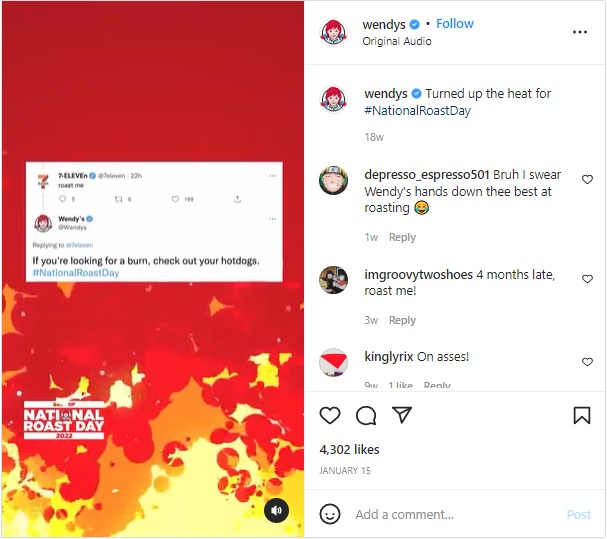
Source: Wendy’s Instagram
Well, we’re not telling you to call out your competitors and roast them, but it’s always best to show your followers your personality to engage them and make them stick around.
#3. You Can Take a Stab at Humor
Done right, humor can make your marketing messages more relatable– and your brand can be seen as more trustworthy and human. Not to mention that funny branding also makes your marketing messages more entertaining and relatable. Remember that according to the study, 88% of respondents view social networking sites like Twitter and Facebook as a new form of entertainment.
Making your social videos humorous imbues them with more shareability. However, the wrong joke at the wrong time can make your brand even look amateurish and unprofessional. The key here is to find a joke that matches your business personality and your target audience.
This iconic YouTube marketing video from Dollar Shave Club stuck with us because it had some kind of humorous element.
They know who their target audience is, so they make funny boasts about their product combined with sitcom-worthy lines. Not to mention that they also include some visual gags.
#4. Demonstrate Your Product
You might see some quick product demonstrations or tutorials on your social media feeds. Showing your product in action can be good video content for your social media marketing strategy.
It helps your followers and target customers gain a good understanding of how your product works, what they can expect from it, and boost the appeal of your products to them, as well as build a sense of familiarity with your brand. At the end of the day, it can help them in their purchase decision.
Here’s an example from Blendtec, a blender company that takes a creative way to demonstrate its products. They blend iPhones, tablets, and even laptops.
Their YouTube channel is quite popular, with more than 850 million subscribers. The Will It Blend series is not only to entertain their subscribers, but also to show how strong their blenders are.
#5. Perform Social Listening
Before you even start creating social media videos, it’s important to do your research and understand the latest trends in the space. When it comes to social media marketing, the trends that users like and the topics of conversations evolve over time. This makes it hard for businesses to keep up.
That’s where social listening fits into the picture. Social listening means that you’re constantly monitoring social media channels for mentions of your brand, as well as relevant keywords and topics.
That way, you can find out what people are talking about. What kind of videos do they currently love to share? In other words, you can get a pulse on the latest trends and figure out how you can create content that appeals to your target audience.
To do this, set up Google Alerts for key phrases related to your industry and check in on social media sites like Twitter and Instagram to see what people are saying. Then, you can start creating video content that targets those topics.
Fitbit is a great example of this. Fitbit uses social listening to gather customer data, the issues they have faced with the app, and collect ideas from their communities. All these insights are then brought to the engineering teams to make adjustments and create a better app. To let their users know, they create a quick video that they share on their social media profiles, including Facebook.
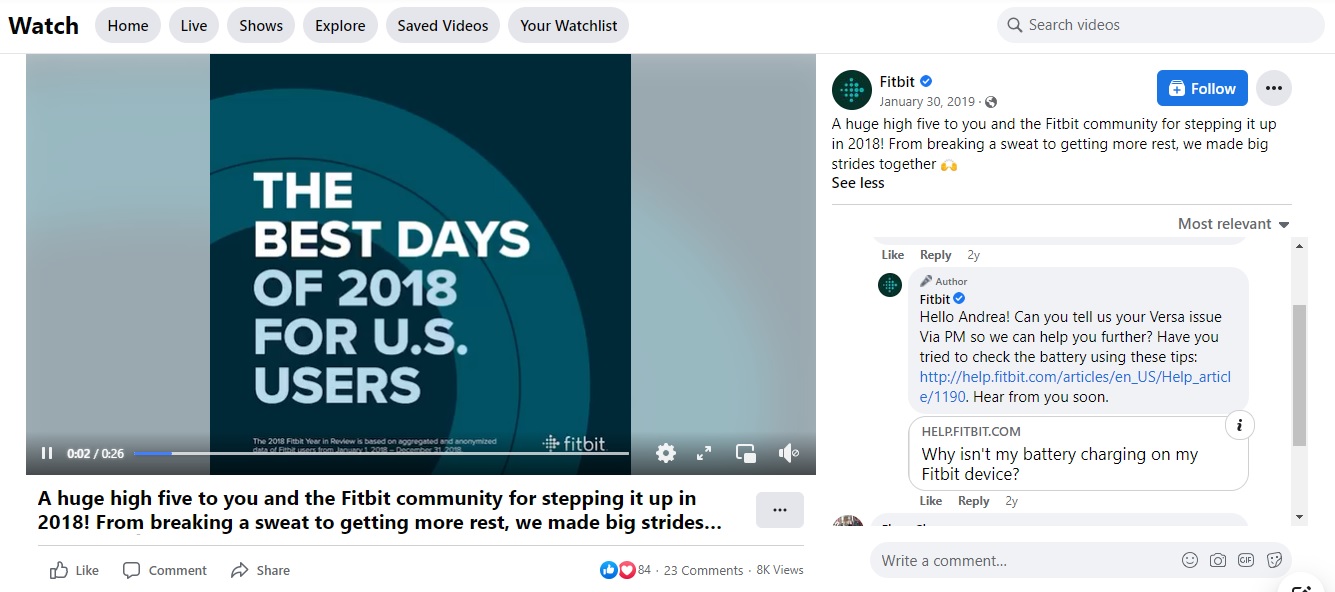
Source: Fitbit Facebook page
#6. Use Brand Activism
More and more brands are using social media as a platform for activism. By taking a stand on important issues, you can show your audience that you care about more than just selling them products. It doesn’t mean that you have to run a major social media campaign with a thousand-buck budget to support a cause, but even small actions can make a big difference.
For example, you can donate to charity, bring awareness to a topic, participate in fundraisers, or support causes that are important to your customers. These kinds of initiatives not only make your brand more socially responsible, but also build trust and loyalty among your customer base.
However, it’s important to make sure that you’re being so thoughtful about the issues you choose to address. Your goal should be to start a conversation, not to alienate potential customers.
Nike is a well-known brand for social causes. One of their most popular activism campaigns is the #YouCantStopOurVoice. This campaign shows their audiences that you don’t have to be a superstar to be heard and make an impact. This campaign aimed to increase voter participation and minimize barriers to voting.
#7 Experiment with Video Formats
A different video format brings different results.
You’re probably familiar with the most popular video format on social media – the square video. Square videos are easy to produce and they work well on all social media platforms. But that doesn’t mean you should limit yourself to only producing square videos.
Experiment with other formats, like vertical or landscape videos, and see how your audience responds.
For example, if you’re targeting users with ephemeral video content on Instagram Stories, Reels, IG Live, Facebook Stories, or YouTube Shorts, vertical videos work best.
But if you want to upload native videos on social media platforms, landscape videos might be a better option. That’s because most platforms have a 16:09 aspect ratio, which is closer to a traditional widescreen format.
Prose wants to engage their followers in real-time, interact with them, and answer their questions in the most “human” way possible. This is why the live-streaming video is the best format to go.
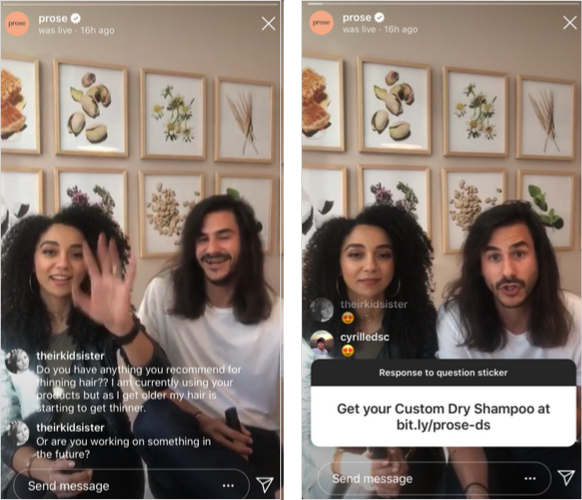
The bottom line here is that you should experiment with different video formats to see what works best for your brand and your audience.
#8. Choose the Right Platform
No social media platform is created the same. Each platform has a different audience, purpose, and set of features. That’s why it’s important to choose the right platform for your social media video marketing strategy.
Let’s say you’re targeting business professionals, LinkedIn would be a better choice than Instagram. If you want to reach a younger audience, TikTok or Instagram would be better options.
The key is to understand the different social media platforms and figure out where your target audience hangs out online. Only then you can get your video seen by the right people.
Here are a few questions to consider when choosing the right platform for your social media video marketing strategy:
- Who is your target audience?
- Where do they hang out online?
- What kind of videos perform well on that platform?
- What kind of resources do you have to produce videos for that platform?
For example, Adecco, a recruitment company, understands who their video is for. It’s created specifically for employers or HR managers. There’s no better place for that than LinkedIn.
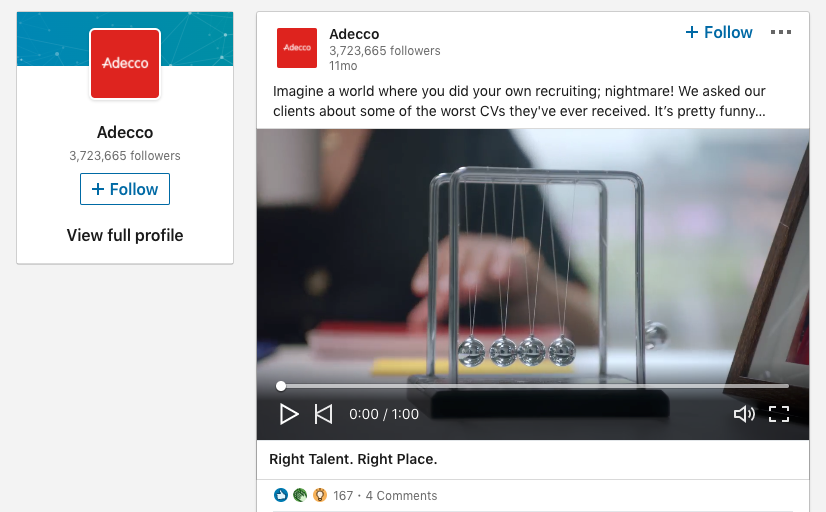
#9. Pay Attention to the Analytics
Building your social media video marketing strategy is so much more than creating a video and making it available. It’s also about understanding how your audience is interacting with your videos and using that data to improve your strategy.
Most social media platforms have built-in analytics tools that give you insights into things like views, watch time, engagement, and more. Instagram Insights is one of those tools.
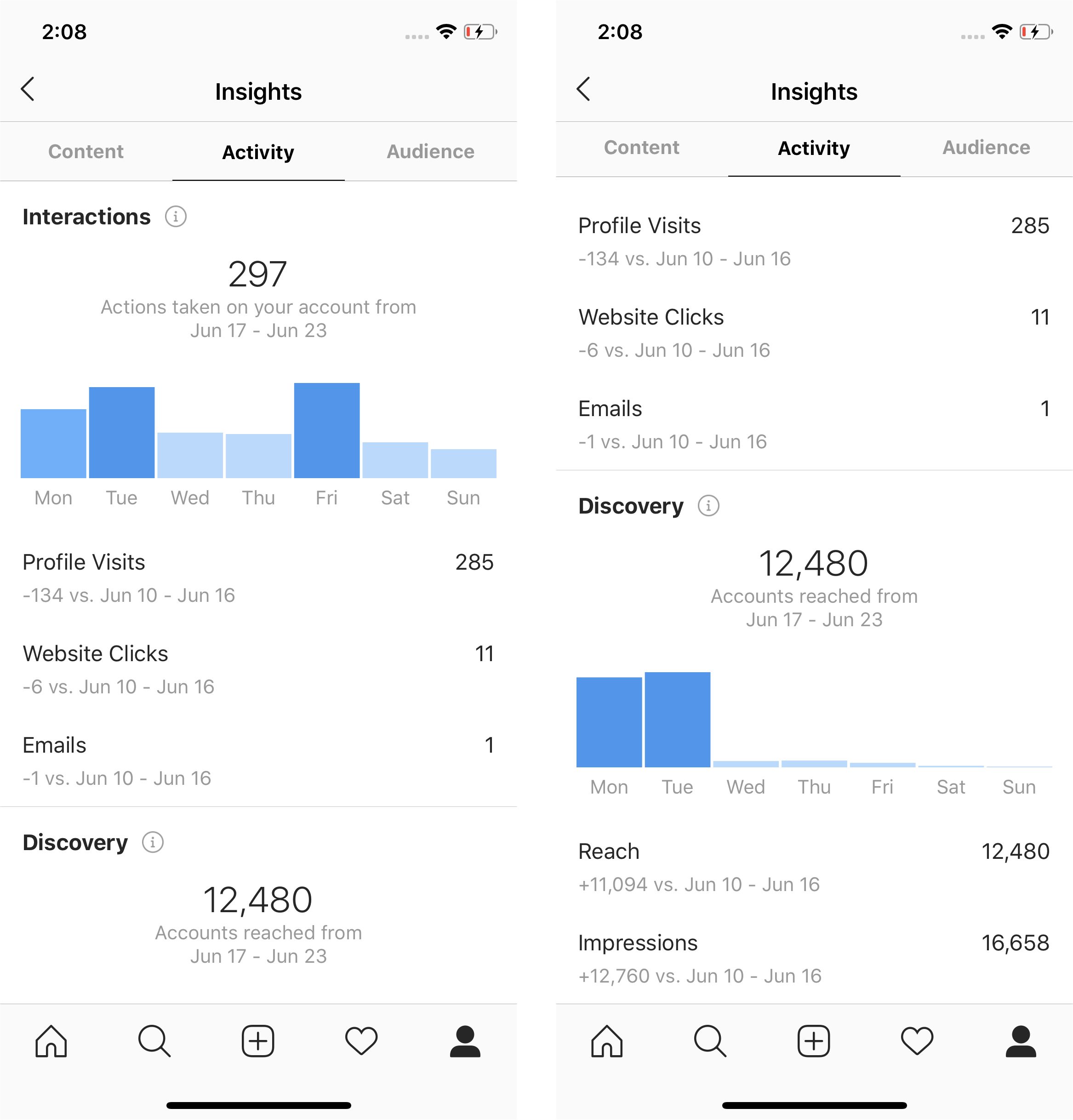
These metrics can help you understand what’s working and what’s not. For example, if you see that one of your videos has a high view count but low watch time, that’s an indication that your audience is losing interest halfway through the video.
Video analytics makes it much easier for you to get an insight into how well your social videos perform, as well as your audience’s behavior and preferences. As a result, you can produce better content that resonates with your audience.
#10. Consistency Is Key
In this fast-paced world, it’s easy to want visible, profiting results with your social video marketing strategy.
The harsh truth is that there’s no such thing as overnight success in overall digital marketing campaigns. You can’t create your first video ever and expect them to go viral overnight.
Consistency plays such an important role here. Make sure you post social videos regularly. Ideally, you should come up with a new video every week. You can create a series of videos to perk your audience’s curiosity and convince them to stick around your brand. That’s how you can build a community around your brand.
For example, Kate Spade creates a #missadventure advertisement series on Facebook and YouTube where they feature Anna Kendrick.
Wrapping Up
Social media video marketing can help you boost your awareness, reach more people, and tell your stories. Of course, if it’s done well and up-to-date. With the 10 best practices and examples above, now you understand how to utilize social media video so your campaign can get the limelight it deserves.










